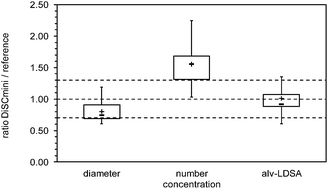A laboratory study of the performance of the handheld diffusion size classifier (DiSCmini) for various aerosols in the 15–400 nm range
Abstract
In addition to chemical composition, particle concentration and size are among the main parameters used to characterize exposure to airborne ultrafine or nanoparticles. To assess occupational inhalation exposure, real-time instruments are recommended in recent strategies published. Among portable devices for personal exposure assessment in the workplace, DiSCmini (Matter Aerosol AG, Switzerland) has been identified as a potential candidate with its capacity to measure the airborne nanoparticle concentration and average particle size with good time-resolution. Monodisperse and polydisperse test nanoaerosols of varying compositions and morphologies were produced in the laboratory using the CAIMAN facility. These aerosols covered a range of particle sizes between 15 and 400 nm and number concentrations from 700 to 840 000 cm−3. The aerosols were used to investigate the behavior of DiSCmini, comparing experimental data to reference data. In spite of a slight tendency to underestimate particle size, all particle diameters, number concentrations and surface area concentrations measured were in the same order of magnitude as reference data. Furthermore, no significant effect due to particle composition or morphology was noted.

- This article is part of the themed collection: AIRMON 2014

 Please wait while we load your content...
Please wait while we load your content...